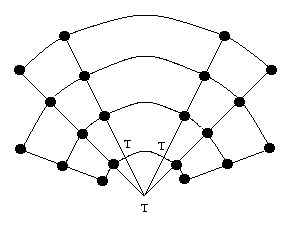Lambs and tigers
The game of Lambs and Tigers is only one of 60 wonderful games from the book "Board Games Round the World'' published by Cambridge University Press 1988 and written by Robbie Bell and Michael Cornelius. This is an excellent resource book for mathematical investigations.

This is a game played by Hindu children in India. One player has 3 tigers and the other 15 lambs. Pieces are placed alternately on the board shown above for the first three moves, the tigers being placed on the points marked 'T' and the lambs on the other points. Thereafter the player with the lambs continues placing them on the board, while the player with the tigers may either move a tiger to an adjacent point or 'kill' a lamb by jumping over it and removing it from the board - several single lambs may be killed by a series of jumps in one move. Lambs cannot move until all 15 have been introduced, when they can move to an adjacent point. The tigers seek to destroy all the lambs while the lambs try to hem in the tigers so that they cannot move.
Some questions to think about:
- In how many ways can a single tiger be placed on the board?
- How many positions are possible with all the lambs and tigers on the board?
- What is the minimum number of lambs needed to trap all three tigers?
- What are the best places to put the lambs initially? Where should the tigers begin to move?
- Consider a simplified game on a smaller board with, say, one tiger and four or five lambs.
